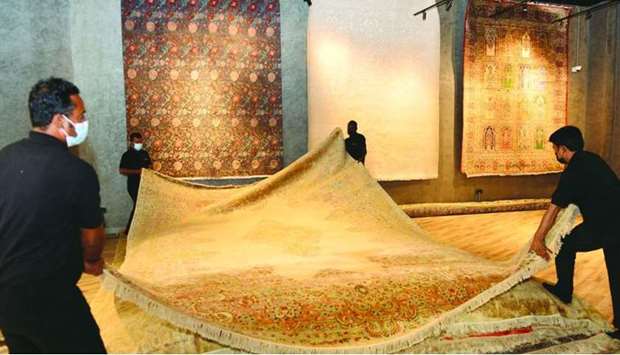Over a long period, Sheel Chandra, the founder of Delhi-based The Carpet Cellar, collected antiques, many of which are centuries old. In his lifetime, he was able to amass 2,200 antique carpets and textiles in his personal collection.
“His idea was not to really sell carpets,” said Sheel’s nephew, Dhruv Chandra, owner and director of The Carpet Cellar, who spoke to Gulf Times at the company’s showroom, which opened only recently at the Msheireb Downtown District in Doha.

“We got into the carpet business by accident…my uncle was a private antique collector, and then eventually, once he had so many – around 2,200 antique carpets and textiles in his personal collection – the family eventually decided that we were going to keep 400 for the museum that we plan to establish in Delhi, India, and we've also decided to part with the rest because we're trying to build a corpus for the museum,” Chandra pointed out.
Inside the showroom at Msheireb, which is The Carpet Cellar’s first store outside of India, are well-curated recreations of antique carpets and some of Sheel Chandra’s original collections. Prominently displayed there is a 100-year old Agra jail carpet from the time of the great Mughal emperor, Akbar, who introduced jail weaving in India in the mid-1500s.
According to Chandra, King Akbar was “a great patron of the arts.” To help reform prisoners from the jails by learning life skills, he brought in master weavers from Iran to teach prisoners how to weave carpets, Chandra said.

“The Safavids are a very famous dynasty that used to rule Iran in the 16th century. This was the glorious rule of carpet making at any point in history. They used to use the best materials. The best of dyes. The best craftsmanship. In the olden times, carpets were made using vegetable dyes or natural dyes, which are extracted from plants, rocks, minerals, stones, so the quality of colours and dyes is unbelievable.
“Today, carpets are generally made at price points. People say a carpet should be $1,000 or $10,000 or $5,000 then you work backward to achieve the price. In the olden times, they use to make it with the labour of love using the best ingredients and the best workmanship over a long period; the skill of the weaver was excellent and you could employ hundreds of people for the job. And there were people who took a lot of pride in their works,” he stressed.
The world's most expensive carpet ever sold was for “$34mn” at the Sotheby’s auction in New York, said Chandra, adding that for centuries, carpets have been used as an asset class among art and antique collectors.
To understand the value of the carpets at The Carpet Cellar, Chandra said most of the carpets in his uncle’s original collections were taken out on ceremonial occasions. “These are from collections of maharajas in India who used to have enormous palaces, which had 200, 300, 500 carpets, and they were put in galleries, bedrooms, and majiles. They were made in astronomically palatial sizes; some are ranging up to 50m in size. Some carpets could take 10 to 20 years to make by 100 to 200 weavers,” he explained.
Chandra also emphasised the immense role and influence of Islamic culture in carpet weaving, citing the Mughal invasion in India. “These kinds of copies are very rare, and I think people need to learn about them: how they were made, what is so special, and what is the quality?
“We have examples of carpets from the 16th century, which of course, can now only be put on walls, but basically, they are works of art, and they should be appreciated. And people should understand what went on to make them and how high the standards were in those times,” he said.
About 250 carpets, “some of the best of the best,” from Sheel Chandra’s collection are curated in Msheireb. The Carpet Cellar’s offering includes “certified antique carpets, perfectly executed recreations, modern designs, as well as kilims, durries, shawls, and textiles.”
“We chose Qatar as The Carpet Cellar’s first store outside of India. And most people would choose New York or London or Paris but we have a lot of patrons in the Middle East.”
He said, “As part of the Islamic culture, people here have lived with carpets for years and centuries – for generations. There are also so many knowledgeable collectors in Qatar, in the Middle East, and in other countries, and I feel we had so many patrons from these places who would come to India or we have been in touch with, so we thought that Doha would be a good place for us.”
“His idea was not to really sell carpets,” said Sheel’s nephew, Dhruv Chandra, owner and director of The Carpet Cellar, who spoke to Gulf Times at the company’s showroom, which opened only recently at the Msheireb Downtown District in Doha.

Dhruv Chandra, owner and director of The Carpet Cellar. PICTURE Shaji Kayamkulam.
“We got into the carpet business by accident…my uncle was a private antique collector, and then eventually, once he had so many – around 2,200 antique carpets and textiles in his personal collection – the family eventually decided that we were going to keep 400 for the museum that we plan to establish in Delhi, India, and we've also decided to part with the rest because we're trying to build a corpus for the museum,” Chandra pointed out.
Inside the showroom at Msheireb, which is The Carpet Cellar’s first store outside of India, are well-curated recreations of antique carpets and some of Sheel Chandra’s original collections. Prominently displayed there is a 100-year old Agra jail carpet from the time of the great Mughal emperor, Akbar, who introduced jail weaving in India in the mid-1500s.
According to Chandra, King Akbar was “a great patron of the arts.” To help reform prisoners from the jails by learning life skills, he brought in master weavers from Iran to teach prisoners how to weave carpets, Chandra said.

Some of the carpets curated at The Carpet Cellar in Msheireb. PICTURE: Shaji Kayamkulam.
“The Safavids are a very famous dynasty that used to rule Iran in the 16th century. This was the glorious rule of carpet making at any point in history. They used to use the best materials. The best of dyes. The best craftsmanship. In the olden times, carpets were made using vegetable dyes or natural dyes, which are extracted from plants, rocks, minerals, stones, so the quality of colours and dyes is unbelievable.
“Today, carpets are generally made at price points. People say a carpet should be $1,000 or $10,000 or $5,000 then you work backward to achieve the price. In the olden times, they use to make it with the labour of love using the best ingredients and the best workmanship over a long period; the skill of the weaver was excellent and you could employ hundreds of people for the job. And there were people who took a lot of pride in their works,” he stressed.
The world's most expensive carpet ever sold was for “$34mn” at the Sotheby’s auction in New York, said Chandra, adding that for centuries, carpets have been used as an asset class among art and antique collectors.
To understand the value of the carpets at The Carpet Cellar, Chandra said most of the carpets in his uncle’s original collections were taken out on ceremonial occasions. “These are from collections of maharajas in India who used to have enormous palaces, which had 200, 300, 500 carpets, and they were put in galleries, bedrooms, and majiles. They were made in astronomically palatial sizes; some are ranging up to 50m in size. Some carpets could take 10 to 20 years to make by 100 to 200 weavers,” he explained.
Chandra also emphasised the immense role and influence of Islamic culture in carpet weaving, citing the Mughal invasion in India. “These kinds of copies are very rare, and I think people need to learn about them: how they were made, what is so special, and what is the quality?
“We have examples of carpets from the 16th century, which of course, can now only be put on walls, but basically, they are works of art, and they should be appreciated. And people should understand what went on to make them and how high the standards were in those times,” he said.
About 250 carpets, “some of the best of the best,” from Sheel Chandra’s collection are curated in Msheireb. The Carpet Cellar’s offering includes “certified antique carpets, perfectly executed recreations, modern designs, as well as kilims, durries, shawls, and textiles.”
“We chose Qatar as The Carpet Cellar’s first store outside of India. And most people would choose New York or London or Paris but we have a lot of patrons in the Middle East.”
He said, “As part of the Islamic culture, people here have lived with carpets for years and centuries – for generations. There are also so many knowledgeable collectors in Qatar, in the Middle East, and in other countries, and I feel we had so many patrons from these places who would come to India or we have been in touch with, so we thought that Doha would be a good place for us.”


